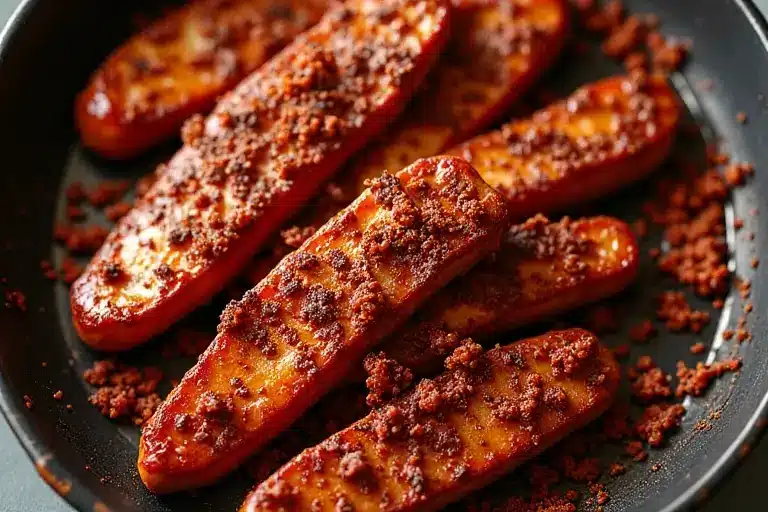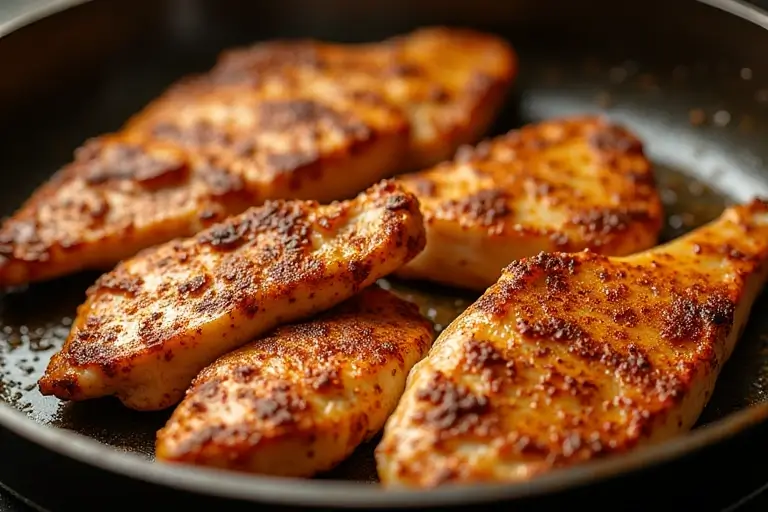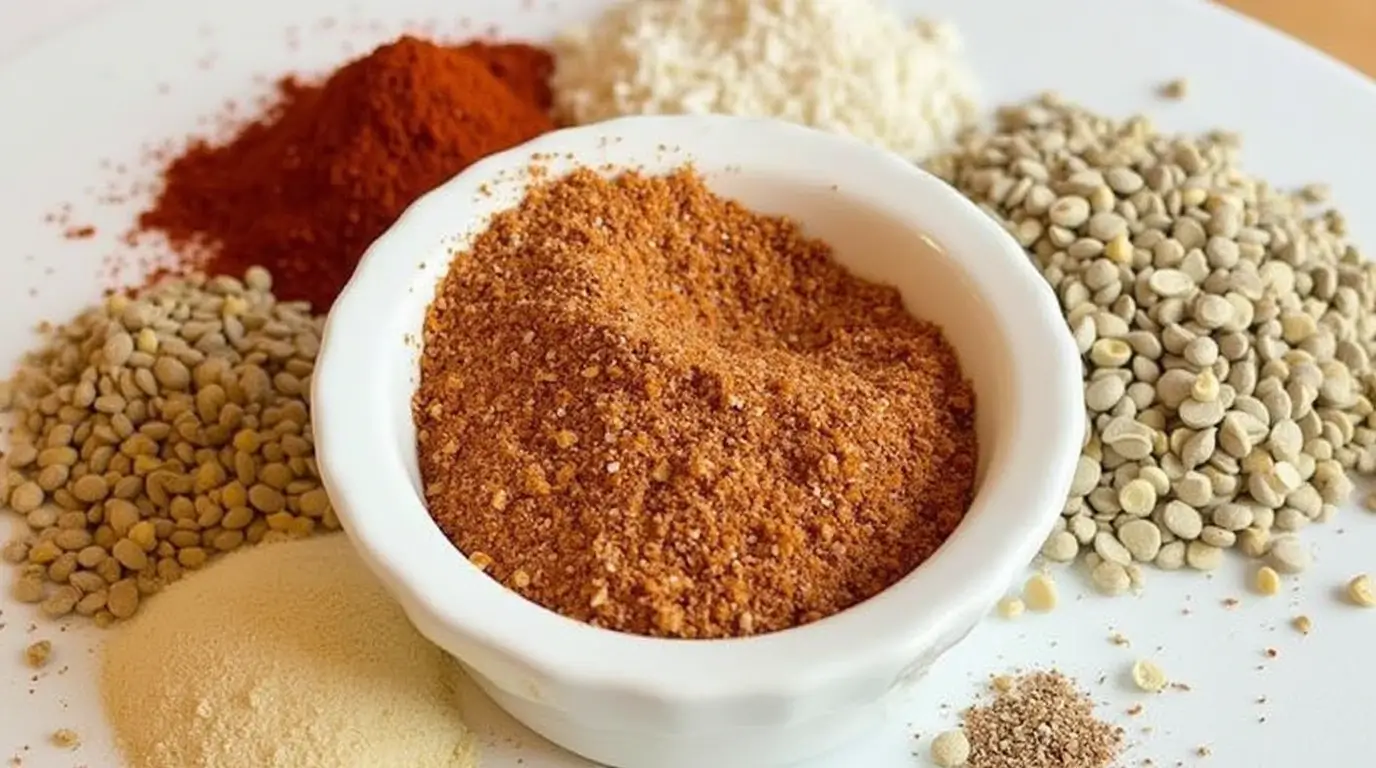Discover how to make your own delicious, customizable fajita seasoning recipe at home. Control the ingredients and create amazing fajita dishes!
Making your own fajita seasoning recipe is easy. It allows for complete control over the flavor. It also lets you avoid unwanted additives. This comprehensive guide provides everything. You’ll learn about ingredients and variations. Therefore, prepare to elevate your fajita game.
Why Make Your Own Fajita Seasoning Recipe? The Benefits Unveiled
Control Over Ingredients: Avoiding Additives
Store-bought fajita seasonings often contain additives. These can include MSG, anti-caking agents, and artificial flavors. Making your own allows you to avoid these. Consequently, you get a cleaner, healthier seasoning blend.
Customization: Tailoring the Flavor to Your Preferences
A homemade fajita seasoning recipe is customizable. You can adjust the spice levels. You can also tweak the balance of flavors. This ensures it perfectly suits your taste. Therefore, it’s a superior option.
Cost-Effectiveness: Saving Money in the Long Run
Making your own seasoning can be more cost-effective. Buying individual spices in bulk is often cheaper. This is compared to buying pre-made mixes. Consequently, you save money over time.
Freshness and Flavor: Maximizing the Impact
Homemade seasoning blends are fresher. They typically have a more vibrant flavor. This is because the spices haven’t been sitting on a shelf for months. Therefore, your fajitas will taste better.
PrintUnlock Flavor: Crafting the Perfect Fajita Seasoning Recipe!
- Total Time: 5 minutes
- Yield: 1/4 cup seasoning 1x
- Diet: Vegan
Description
A bold and flavorful homemade fajita seasoning blend made with pantry spices—perfect for chicken, steak, or veggie fajitas. No fillers, just pure flavor.
Ingredients
1 tablespoon chili powder
1 1/2 teaspoons ground cumin
1 teaspoon smoked paprika
1 teaspoon garlic powder
1 teaspoon onion powder
1/2 teaspoon dried oregano
1/2 teaspoon salt
1/4 teaspoon black pepper
1/4 teaspoon cayenne pepper (optional, for heat)
Instructions
1. Combine all the spices in a small bowl.
2. Whisk together until evenly mixed.
3. Transfer to an airtight jar or container and store in a cool, dry place.
4. Use about 1 to 2 tablespoons of seasoning per pound of meat or vegetables.
5. Adjust salt and cayenne to taste.
Notes
This seasoning mix keeps well for up to 6 months if stored properly.
Use it for fajitas, tacos, grilled meats, or roasted vegetables.
For a lower sodium version, reduce or omit the salt and adjust when cooking.
- Prep Time: 5 minutes
- Cook Time: 0 minutes
- Category: Spice Blend
- Method: No Cook
- Cuisine: Mexican
Nutrition
- Serving Size: 1 tablespoon
- Calories: 10
- Sugar: 0g
- Sodium: 150mg
- Fat: 0g
- Saturated Fat: 0g
- Unsaturated Fat: 0g
- Trans Fat: 0g
- Carbohydrates: 2g
- Fiber: 1g
- Protein: 0g
- Cholesterol: 0mg
Keywords: fajita seasoning, spice mix, homemade seasoning, Tex-Mex
Essential Spices for a Delicious Fajita Seasoning Recipe
Chili Powder: The Foundation of Flavor
Chili powder is the base of most fajita seasoning recipes. It provides warmth and depth. Different types of chili powder exist. For example, there is ancho, chipotle, and New Mexico chili powder. Each offers a unique flavor profile.
Cumin: Adding Earthy Warmth
Cumin is another crucial ingredient. It adds an earthy, warm flavor. This complements the chili powder. Ground cumin is readily available. However, toasting whole cumin seeds and grinding them enhances the flavor.
Paprika: Sweetness and Color
Paprika contributes sweetness and a vibrant red color. Smoked paprika adds a smoky flavor. Sweet paprika provides a milder taste. Therefore, choose according to your preference.
Garlic Powder: Essential Savory Note
Garlic powder is essential. It provides a savory note. It rounds out the flavor profile. Granulated garlic can also be used. However, garlic powder disperses more evenly.
Onion Powder: Adding Depth and Complexity
Onion powder adds depth and complexity. It complements the garlic powder. It creates a well-rounded, savory base. Similar to garlic, granulated onion is an option.
Oregano: A Touch of Herbaceousness
Oregano adds a touch of herbaceousness. Mexican oregano is preferred. It has a slightly different flavor than Mediterranean oregano. It complements the other spices well.
Salt: Enhancing the Flavors
Salt is crucial. It enhances all the other flavors. Use kosher salt or sea salt. Avoid iodized salt, which can have a slightly metallic taste. Adjust the amount to your preference.
Black Pepper: A Bit of Bite
Black pepper adds a bit of bite. Freshly ground black pepper has the best flavor. Adjust the amount to control the spiciness. Therefore, it is a key component.

Optional Ingredients to Customize Your Fajita Seasoning Recipe
Cayenne Pepper: For Extra Heat
Cayenne pepper adds significant heat. Use it sparingly if you prefer a milder blend. Add more for a fiery kick. Therefore, adjust carefully.
Smoked Paprika: For a Smoky Flavor
Smoked paprika adds a distinct smoky flavor. This is a great addition to grilled fajitas. It complements the char from the grill. Consequently, it enhances the overall taste.
Coriander: Adding Brightness
Ground coriander adds a bright, citrusy note. This complements the other spices. It’s a common ingredient in some Mexican spice blends. Therefore, consider adding it.
Sugar: Balancing the Flavors
A small amount of sugar can balance the flavors. It enhances the sweetness of the paprika. Brown sugar or white sugar can be used. However, use it sparingly.
Dried Cilantro: Adding a Fresh Element
Dried cilantro adds a fresh, herbaceous element. This complements the other spices. It’s a good alternative to fresh cilantro. If you enjoy the flavor, add it.
Crafting Your Signature Fajita Seasoning Recipe: A Step-by-Step Guide
Basic Fajita Seasoning Recipe
This recipe provides a well-balanced starting point. You can customize it to your liking.
- 2 tablespoons chili powder
- 1 tablespoon ground cumin
- 1 tablespoon paprika
- 1 tablespoon garlic powder
- 1 tablespoon onion powder
- 1 teaspoon dried oregano
- 1 teaspoon salt
- 1/2 teaspoon black pepper
Instructions: How to make your own fajita mix.
- Combine all ingredients in a small bowl.
- Mix thoroughly until evenly distributed.
- Store in an airtight container.
Spicy Fajita Seasoning Recipe
For those who like it hot, increase the heat.
- Basic fajita seasoning recipe (above)
- 1-2 teaspoons cayenne pepper
Instructions:
- Combine all ingredients, including cayenne pepper.
- Mix well.
- Store in an airtight container.
Smoky Fajita Seasoning Recipe
Add a smoky flavor with this variation.
- Basic fajita seasoning recipe (above)
- 1-2 tablespoons smoked paprika (instead of regular paprika)
Instructions:
- Use smoked Paprika in place of some of the other Paprika.
- Combine all ingredients, including smoked paprika.
- Mix well.
- Store in an airtight container.
Mild Fajita Seasoning Recipe
For a milder flavor, reduce the pepper.
- Basic fajita seasoning recipe (above)
- Omit or reduce the black pepper
- Omit cayenne pepper (if using)
Instructions:
- Combine all ingredients, adjusting pepper to taste.
- Mix thoroughly.
- Store in an airtight container.
Blending the Spices: Ensuring Even Distribution
Thoroughly mix the spices. This ensures even distribution of flavor. Use a whisk or a fork. Alternatively, pulse the spices in a spice grinder. This creates a finer blend.

Storing Your Homemade Fajita Seasoning Recipe: Maximizing Shelf Life
Airtight Containers: Essential for Freshness
Store your fajita seasoning recipe in an airtight container. This prevents moisture and air from affecting the spices. Glass jars or spice containers are ideal. Consequently, the spices stay fresh.
Cool, Dark, and Dry Place: Ideal Storage Conditions
Keep the seasoning in a cool, dark, and dry place. Avoid storing it near the stove or in direct sunlight. Heat and light can degrade the spices. Therefore, choose a pantry or cupboard.
Shelf Life: How Long Does Homemade Seasoning Last?
Homemade seasoning blends typically last for 6-12 months. However, the flavor may gradually diminish over time. For best results, use it within 6 months. Therefore, make smaller batches.
Using Your Fajita Seasoning Recipe: Tips and Techniques
Marinating the Meat: Enhancing Flavor Penetration
Marinating the meat with the fajita seasoning recipe is crucial. It allows the flavors to penetrate. Marinate for at least 30 minutes. For best results, marinate for several hours or overnight. Therefore, plan.
Cooking Methods: Grilling, Pan-Frying, and Baking
Fajitas can be cooked using various methods. Grilling adds a smoky flavor. Pan-frying is a convenient option. Baking is suitable for larger batches. Therefore, choose your preferred method.
How much fajita seasoning do you use per pound of chicken?
Generally, use 1-2 tablespoons of the fajita seasoning recipe per pound of chicken. Adjust the amount to your taste. For other meats, the amount may vary slightly. Therefore, start with less and add more.
Adding Vegetables: Onions and Bell Peppers
Onions and bell peppers are classic fajita vegetables. Add them to the marinade with the meat. Alternatively, cook them separately. They provide sweetness and texture.
Serving Suggestions: Tortillas, Toppings, and Sides
Serve fajitas with warm tortillas. Offer a variety of toppings. These can include salsa, guacamole, sour cream, and cheese. Rice and beans are traditional sides.
Don’t miss our Strawberry Dubai Chocolate: A Gourmet Treat for Chocoholics to balance your savory meal with a luxurious dessert.
Beyond Chicken: Using the Fajita Seasoning Recipe with Other Proteins
Beef Fajitas: A Classic Choice
The fajita seasoning recipe works beautifully with beef. Skirt steak and flank steak are popular choices. Marinate the beef for several hours. This tenderizes it and adds flavor.
Shrimp Fajitas: A Quick and Delicious Option
Shrimp cooks quickly. It’s a great choice for fajitas. Marinate the shrimp for a shorter time, about 30 minutes. Be careful not to overcook them.
Pork Fajitas: A Flavorful Alternative
Pork tenderloin or pork shoulder can be used for fajitas. Marinate the pork for several hours. This enhances its flavor and tenderness. Therefore, it’s a delicious option.
Tofu Fajitas: A Vegetarian Option
The fajita seasoning recipe can be used with tofu. Press the tofu to remove excess water. Then, marinate it with the seasoning. This adds flavor to the tofu.
Vegetable Fajitas: A Meatless Delight
Use the seasoning with a variety of vegetables. Mushrooms, zucchini, and squash are good choices. They complement the onions and bell peppers. Consequently, it creates a flavorful meal.
Adapting the Fajita Seasoning Recipe for Other Dishes
Tacos: A Similar Flavor Profile
The fajita seasoning recipe can be used to season taco meat. It provides a similar flavor profile. Adjust the amount to your liking. Therefore, it’s a versatile option.
Quesadillas: Adding a Kick
Sprinkle the seasoning on the quesadillas. This adds a kick of flavor. Use it with cheese, chicken, or vegetables. Therefore, it enhances the dish.
Soups and Stews: Enhancing Depth of Flavor
Add a small amount of the seasoning to soups and stews. It adds depth and complexity. It complements other Mexican-inspired flavors. Therefore, experiment with it.
Roasted Vegetables: A Flavorful Side Dish
Toss vegetables with the fajita seasoning recipe. Then, roast them in the oven. This creates a flavorful side dish. It works well with root vegetables.
Marinades and Dressings: Expanding the Possibilities
Use the seasoning as a base for marinades. Alternatively, add it to salad dressings. It provides a Southwestern flavor. Therefore, it’s versatile in the kitchen.

Troubleshooting Common Fajita Seasoning Recipe Issues
Too Salty: Adjusting the Salt Content
If the seasoning is too salty, reduce the salt. You can also add more of the other spices. This dilutes the saltiness. Therefore, adjust to your taste.
Too Spicy: Toning Down the Heat
If the seasoning is too spicy, reduce the cayenne pepper. You can also omit the black pepper. Adding a small amount of sugar can also help.
Not Flavorful Enough: Boosting the Taste
If the seasoning lacks flavor, add more spices. Increase the chili powder, cumin, or paprika. Make sure your spices are fresh. Older spices lose their potency.
Clumping: Preventing and Fixing
Clumping can occur due to moisture. Store the seasoning in an airtight container. Add a few grains of rice to the container. This absorbs moisture. If clumping occurs, break it up with a fork.
Frequently Asked Questions about the Fajita Seasoning Recipe
Does fajita seasoning have gluten?
Most fajita seasoning recipes are naturally gluten-free. However, always check the labels of individual spices. Some may be processed in facilities that also handle gluten. Homemade seasoning is generally safer.
How much fajita seasoning do you use per pound of chicken?
Generally, use 1-2 tablespoons of the fajita seasoning recipe per pound of chicken. Adjust this to your preference.
What is fajita seasoning made of?
Fajita seasoning is typically made of chili powder, cumin, paprika, garlic powder, onion powder, oregano, salt, and pepper. Other optional ingredients can be added.
How to make your own fajita mix?
To make your own fajita mix, combine the spices listed above. Mix them thoroughly. Store in an airtight container. It’s that simple.
How to make fajita sauce?
This article focuses on seasoning, not a liquid sauce. Many recipes exist online for fajita sauces. These often involve combining the seasoning with other ingredients. For example, add lime juice, oil, and sometimes broth or tomato sauce.
What are the ingredients in fajitas?
Traditional fajitas include marinated meat (often beef or chicken), grilled onions and bell peppers, and warm tortillas. Toppings such as salsa, guacamole, and sour cream are often added.
Unleash Your Inner Chef with a Homemade Fajita Seasoning Recipe
Making your own fajita seasoning recipe is rewarding. It allows for customization and control. It also ensures freshness and flavor. With this guide, you can create amazing fajitas. Experiment with variations. Enjoy the delicious results. Therefore, start blending today!

